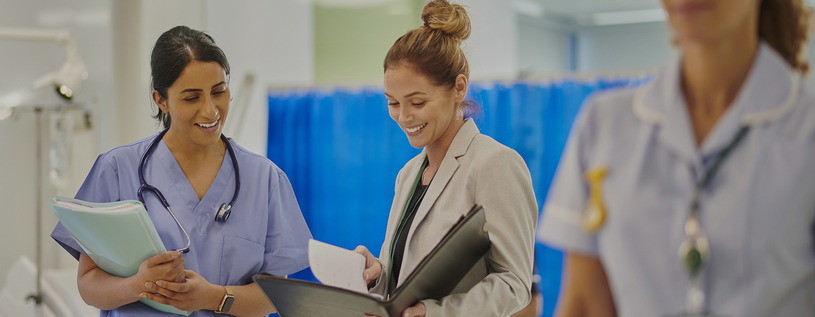Finest Practices in Medical Administration for Improving Efficiency and Decreasing Expenses
In the ever-evolving landscape of medical care, the search of ideal techniques in clinical administration is critical for enhancing efficiency and suppressing costs. By integrating advanced technologies such as digital wellness documents and telemedicine, doctor can improve operations and enhance client treatment. Nevertheless, technology alone is not a panacea; optimizing source allowance and cultivating joint interaction among care groups are equally crucial (medical administration). As organizations make every effort to balance quality and cost, what approaches should be prioritized to attain these twin goals? The solution to these inquiries hold the key to an extra sustainable health care system.
Leveraging Advanced Modern Technology
In today's rapidly advancing healthcare landscape, leveraging advanced technology is no longer optional however crucial for reliable medical administration. The integration of digital services into healthcare systems has transformed the way facilities operate, streamlining processes and enhancing client care. Electronic Health Records (EHRs) are pivotal, offering extensive client data that can be accessed quickly by licensed workers, thus minimizing redundancy and lessening errors. By streamlining client info, EHRs eliminate the need for difficult documentation and assist in seamless communication among healthcare service providers.
Telemedicine is another technical innovation that has revolutionized person communication. It provides convenience for both individuals and medical care experts by allowing remote appointments, which can lower the need for in-person gos to and optimize consultation scheduling. Additionally, telehealth platforms can extend healthcare accessibility to rural or underserved locations, bridging spaces in treatment shipment.
In addition, using Expert system (AI) and device understanding is ending up being significantly prevalent in anticipating analytics, permitting for early discovery of possible health problems and even more informed decision-making. These innovations, when incorporated properly, can improve analysis precision and personalize client therapy strategies, inevitably leading to improved health care end results and operational performance.
Optimizing Resource Allowance
Efficient resource allowance is critical for taking full advantage of the effectiveness of clinical management. By purposefully managing resources such as personnel, equipment, and finances, health care facilities can substantially boost their functional efficiency, boost person end results, and lower unneeded expenses. The initial action in maximizing source allowance entails carrying out a detailed analysis of existing properties and recognizing locations where sources may be underutilized or overextended. This evaluation ought to be data-driven, utilizing metrics and analytics to inform decision-making procedures.
Focusing on resource allocation based on patient demands and solution demands is vital. This includes aligning resources with high-demand locations, such as emergency care or specialized therapies, to make sure timely and reliable individual care. Applying versatile staffing models can also optimize labor sources by changing personnel allocation in response to rising and fall patient quantities. Additionally, welcoming telemedicine and various other technical services can relieve physical resource restraints by offering alternate avenues for patient-provider interactions.
Funds should be thoroughly kept track of and designated with critical foresight to support both short-term operational requirements and long-lasting institutional objectives. This consists of investing in training programs that boost staff competencies and embracing energy-efficient methods that minimize functional prices (medical administration). Inevitably, a maximized resource allocation method promotes a lasting medical care environment that is responsive, effective, and monetarily prudent
Streamlining Workflow Processes
When health care centers purpose to boost operational efficiency, streamlining process procedures comes to be a crucial emphasis. Reliable operations minimize redundancy, get rid of unneeded steps, and boost sychronisation amongst medical care specialists. This approach not only accelerates solution distribution yet additionally boosts the my review here top quality of person care.

Next, modern technology integration plays a considerable role in enhancing operations. Executing digital health records (EHRs) and digital physician order entrance (CPOE) systems lowers paperwork, lessens human mistake, and guarantees info comes to all appropriate employees. In addition, leveraging telemedicine platforms can simplify client examinations and follow-ups, lowering the strain on physical infrastructure.

Inevitably, streamlined operations bring about set you back decreases and boosted person complete satisfaction, cultivating an extra lasting health care environment.
Enhancing Data Management
Structure upon structured process, optimizing data monitoring comes to be a crucial element beforehand healthcare management. Effective data management systems are important for maintaining exact person documents, boosting decision-making, and making certain compliance with regulatory criteria. By carrying out robust data monitoring options, healthcare centers can boost the high quality of patient treatment while all at once lowering operational costs.
One secret element of improving Learn More information administration is the integration of innovative electronic health document (EHR) systems. These systems facilitate the smooth exchange of client details throughout different divisions, minimizing duplication of examinations and lessening mistakes. A well-designed EHR system sustains data analytics, making it possible for doctor to identify fads and make informed choices relating to person care.
Moreover, securing individual data is paramount. Taking on comprehensive cybersecurity procedures, consisting of file encryption and routine audits, ensures the stability and confidentiality of delicate details. This not only secures people however additionally preserves the institution's online reputation.
Purchasing staff training is an additional important factor. Informing medical care professionals on data administration techniques enhances their capacity to effectively use modern technology, resulting in boosted patient outcomes. To conclude, improving data administration via innovative modern technology and thorough training is essential for achieving efficiency and cost reduction in clinical management.
Fostering Collaborative Interaction
A critical component beforehand clinical management is cultivating joint interaction among health care experts. Effective communication is critical for making certain smooth individual treatment, optimizing treatment outcomes, and lessening errors. By encouraging open dialogue and control throughout multidisciplinary teams, healthcare companies can improve their operational efficiency and lower unneeded costs.
Central to this approach is the assimilation of communication innovations such as electronic wellness records (EHRs) and secure messaging systems, which help with the rapid exchange of essential patient details. These tools enable doctor to gain access to and share data in actual time, making sure that all staff member are educated and lined up in their decision-making processes. In addition, normal group meetings and interdisciplinary rounds can further advertise a culture of partnership and review accountability.
Educating programs concentrated on enhancing communication abilities are also crucial. These programs can assist personnel establish the capability to share details clearly and pay attention actively, hence lowering misconceptions and fostering a supportive workplace. Furthermore, taking on standardized interaction procedures, such as SBAR (Scenario, Background, Analysis, Recommendation), can improve the exchange of details, guaranteeing that essential details are conveyed succinctly and successfully. Inevitably, fostering collaborative interaction brings about improved healthcare shipment and price savings (medical administration).

Verdict
Incorporating innovative modern technology, such as electronic health records and telemedicine, alongside enhanced resource allotment and streamlined process procedures, is essential for enhancing effectiveness in medical administration. Reliable information administration and promoting collaborative interaction amongst medical care teams are vital for lessening redundancies and enhancing care quality. By focusing on precautionary care and engaging in top quality enhancement initiatives, healthcare companies can accomplish significant price savings and improved patient end results, therefore making sure sustainable healthcare distribution in a progressively complex setting.
Comments on “Understanding the Secret Functions and Duties in Medical Administration”